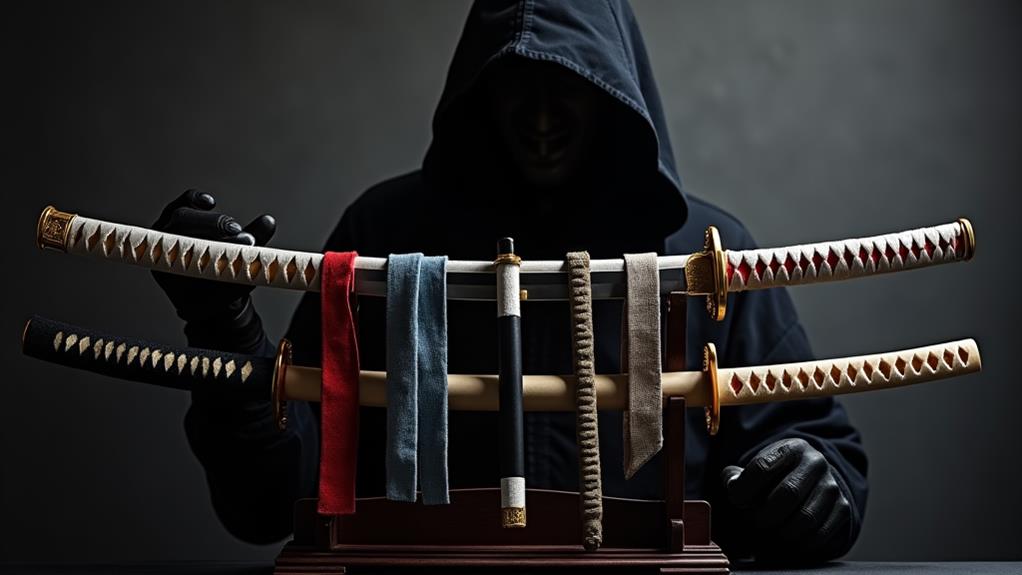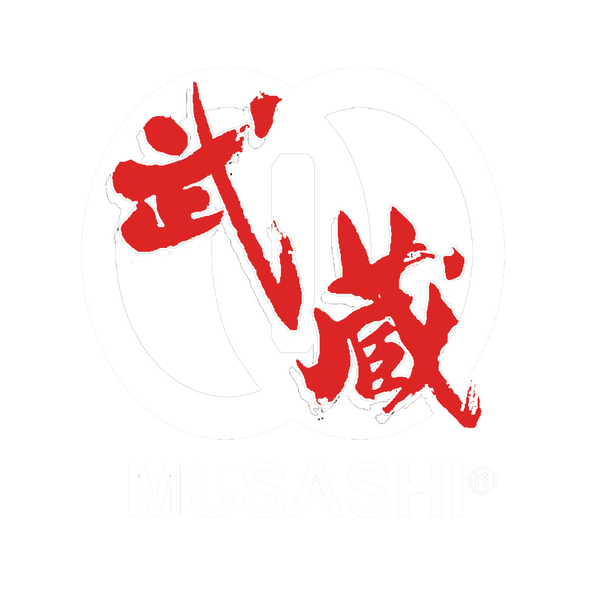
The color of a katana reveals much about its wielder's personality and values. Black katanas symbolize mystery and power, while red ones represent passion and aggression. Blue katanas embody calmness and strategic thinking, and white ones stand for purity and honor. Gold katanas signify wealth and prestige, often intimidating opponents with their opulent appearance. Green katanas reflect growth and harmony, connecting the wielder to nature and spiritual balance. Each color choice tells a unique story about the samurai's character, aspirations, and approach to combat. Understanding these symbolic meanings can provide deeper insights into the rich traditions of Japanese sword culture.
Key Takeaways
- Black katanas suggest a mysterious and powerful persona, emphasizing authority and strategic thinking.
- Red katanas symbolize passion and aggression, reflecting a warrior's fierce determination and fiery spirit.
- Blue katanas represent wisdom and calmness, indicating a strategic and adaptable approach to combat.
- White katanas embody purity and honor, reflecting a commitment to simplicity and unblemished reputation.
- Gold katanas symbolize wealth and prestige, suggesting a desire for control and superior resources.
Black: Mystery and Power
Two primary qualities are associated with black katanas: mystery and power. The deep, dark color of these blades evokes a sense of hidden depths, drawing the eye and intriguing the mind. Black katanas command attention and respect, symbolizing the wielder's authority and strength. Swords are imbued with spiritual and cultural meaning, and the choice of a black katana may also suggest a connection to the ideals of bravery and honor found in the samurai spirit the ideals of bravery and honor.
The enigmatic nature of black swords reflects the complexity of their owners. Those who choose black katanas often possess a desire for control and a penchant for keeping their true intentions concealed. This color choice suggests a strategic mindset and the ability to strike from the shadows.
In battle, a black katana can be a psychological weapon, instilling fear and uncertainty in opponents. The blade's darkness may obscure its movements, adding an element of surprise to each strike. Ultimately, a black katana represents power through mystery, appealing to those who value discretion and dominance.
Red: Passion and Aggression
While black katanas embody mystery and power, red katanas represent a markedly different set of qualities. Red katanas symbolize passion and aggression, tapping into the wielder's primal instincts and impulse. The vibrant crimson hue evokes images of blood and fire, reflecting the ferocity and rage often associated with intense combat. These katanas may also draw inspiration from the rich tradition of samurai swords, which have long been symbols of power and status within Japanese culture the samurai's cultural significance.
Choosing a red katana indicates a desire to harness raw emotions and channel them into decisive action. This color appeals to those who seek to dominate their opponents through sheer force of will and unrelenting determination. The red blade serves as a constant reminder of the warrior's burning desire for victory, fueling their aggressive fighting style. It's a choice that demands respect and warns adversaries of the wielder's readiness to unleash their full potential in battle.
Blue: Calmness and Strategy
In contrast to the fiery red, blue katanas symbolize calmness and strategic thinking. These swords represent a warrior who values reflection and composure over impulsive action. Blue blade wielders are often seen as wise and level-headed, able to maintain their cool even in the heat of battle. The pivotal parts of a katana, such as the blade (ken) and handle (tsuka), contribute to its overall balance and elegance, enhancing the user's ability to approach combat with serenity.

The color blue embodies patience and foresight, qualities indispensable for a skilled strategist. Warriors who choose blue katanas are typically methodical in their approach, carefully planning each move before striking. This calculated style of combat often proves more effective than brute force alone.
Blue katanas also signify a deep connection to water, an element associated with adaptability and fluidity. Those who carry these swords are believed to possess the ability to flow around obstacles and find creative solutions to complex problems, making them formidable opponents in both physical and mental conflicts.
White: Purity and Honor
The pristine white katana stands as a symbol of purity and honor in Japanese sword tradition. This color choice reflects the warrior's commitment to simplicity and humility, two virtues highly esteemed in samurai culture.
A white blade represents the clarity of mind and purpose that comes from inner reflection and discipline.
Choosing a white katana signifies a dedication to maintaining an unblemished reputation and upholding a strict moral code. It embodies the idea of a "blank slate," allowing the wielder to write their own story through honorable actions.
The stark simplicity of white also serves as a reminder to cut away unnecessary distractions and focus on the core aspects of swordsmanship and life. For those seeking to project an image of integrity and moral strength, the white katana is an ideal choice.
Gold: Wealth and Prestige
Gold katanas symbolize wealth, power, and prestige in Japanese sword tradition. These opulent blades represent the pinnacle of social stature and are often associated with nobility and high-ranking samurai. The extravagance of a gold katana reflects the owner's prominence in society, commanding respect and admiration from others.

Choosing a gold katana demonstrates a desire for control and influence. It signifies not only material wealth but also spiritual abundance and success. The gleaming gold finish serves as a visual record of the wielder's accomplishments and authority. In battle, a gold katana may intimidate opponents, suggesting the user's superior resources and training. While some may view gold katanas as ostentatious, they remain powerful symbols of achievement and social standing in Japanese sword culture.
Green: Growth and Harmony
Green katanas embody two crucial aspects in Japanese sword symbolism: growth and harmony. These swords represent a deep connection to nature and spiritual balance, appealing to those seeking inner peace and personal development. The green hue signifies a journey of self-improvement and introspection, making it an ideal choice for practitioners focused on honing their skills and character.
Choosing a green katana demonstrates:
- A commitment to personal growth and lifelong learning
- An appreciation for balance in both swordsmanship and life
- A desire for harmony with nature and one's surroundings
The natural connection associated with green katanas extends beyond physical attributes, encompassing spiritual growth and environmental awareness. By wielding a green blade, swordsmen align themselves with the principles of balance and introspection, pursuing mastery not only in technique but also in their understanding of the world around them.
Frequently Asked Questions
Can Katana Colors Be Customized or Mixed for Personal Symbolism?
Katana colors can indeed be customized to reflect personal design preferences. Skilled artisans can create unique color combinations tailored to individual tastes. This customization allows sword owners to exert control over their blade's aesthetic and symbolic representation.
How Do Katana Color Meanings Vary Across Different Japanese Regions?
Variations in katana color symbolism exist across rural and urban regions of Japan. Eastern and western areas may interpret colors differently. Regional traditions and local customs influence these distinctions, reflecting diverse cultural nuances in sword aesthetics and symbolism.
Are There Any Taboos or Negative Associations With Certain Katana Colors?
Certain katana colors carry ominous connotations and cultural taboos. Black may symbolize death or misfortune, while pure white could imply purity to an extreme. Red might evoke bloodshed. Understanding these associations helps practitioners avoid unintended messages through color choices.
Do Katana Color Meanings Change When Combined With Specific Handle Designs?
Katana color meanings can indeed shift when combined with customized hand guards and distinctive blade finishes. These elements work together to create a unique aesthetic, allowing owners to exert greater control over their sword's symbolism and personal significance.
How Have Katana Color Symbolisms Evolved Throughout Japanese History?
Katana color symbolism has transformed markedly throughout Japanese history. During wartime, colors reflected warrior status and clan affiliations. In peacetime, ceremonial katana color symbolism developed, emphasizing aesthetic preferences and social standing within the samurai class.
Conclusion
The symbolism of katana colors offers insight into the bearer's character and values. Each hue represents distinct qualities, from black's mystery to green's harmony. While these associations are not definitive, they provide a framework for understanding the cultural significance of sword aesthetics in Japanese martial traditions. Ultimately, the choice of katana color reflects both personal preference and the desired projection of one's attributes in the art of swordsmanship. Musashi Swords offers a wide range of katana colors, allowing practitioners to select a blade that aligns with their personal symbolism and aesthetic preferences.


